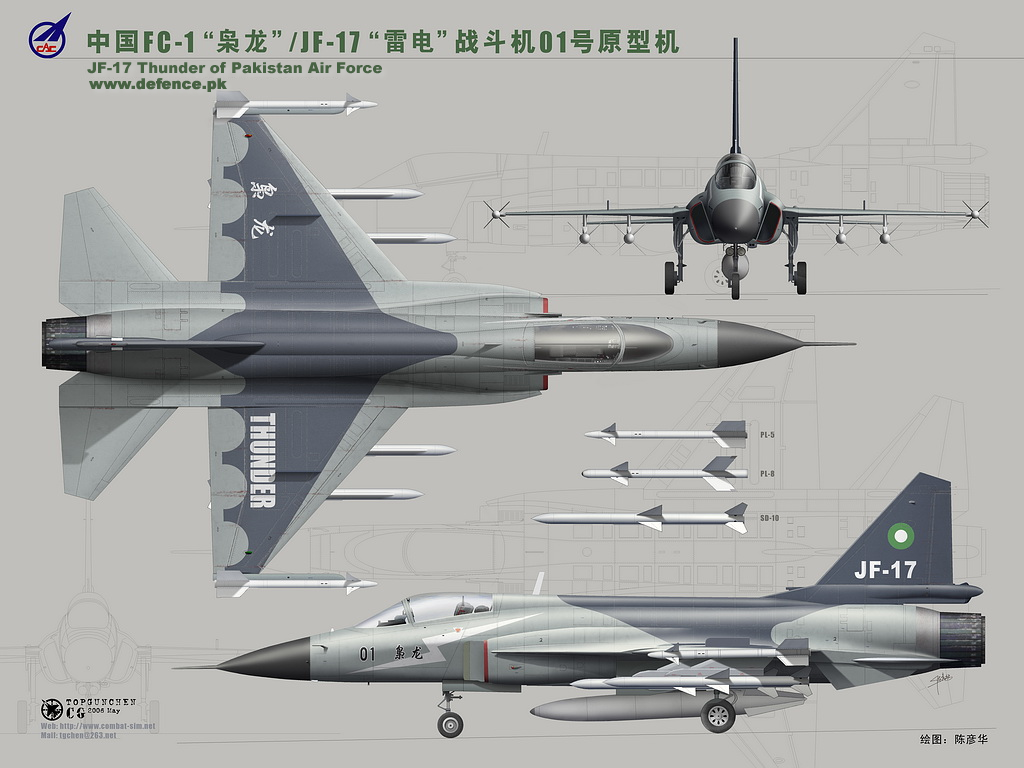Chinese Jets Today At Bygone Price, It's cheep and good plane
ZHUHAI, CHINA– Airshow China is hosting the first international demonstration of the Chengdu JF-17/FC-1, flown here by a team from the Pakistan air force. Officials from China’s Aviation Industries of China (Avic) and China Aero-Technology Import Export Corporation (Catic) tell Aviation Week that despite the low price of the aircraft, it is not a low-tech piece of equipment, but rather a “21st century product.”
Catic Vice President Zeng Wen told Show News “one of the most impressive features of the JF-17 is its diverterless air inlets – negating the need for the intakes to be designed with a boundary layer diverter. This is an achievement in aerodynamics that only the most advanced aircraft designs in the world are configured with – and those others are very high-priced designs like the F-22 or F-35. Another element is that the avionics package of the JF-17 is very advanced – it is equivalent to most of the top-level aircraft in the world. There is also a full glass cockpit.”
What makes the JF-17 a lower-priced platform given its performance is that it is not an aircraft that was designed from scratch, says Catic. Instead, its onboard systems are a scaled-downed adaptation of the configuration from the other famous Chengdu fighter, the J-10. “This transfer of technology — transposing the aircraft systems from the J-10 to the JF-17 — is what makes the JF-17 so cost-effective,” Catic says.
Catic cannot confirm which nations are interested in either a JF-17 or J-10 purchase — although there has been significant interest in both platforms by different countries. A shortlist of prospective buyers for the JF-17 includes Bangladesh, Sri Lanka, Egypt, Nigeria and others. What Catic will say is that “almost any of these countries which have in inventory MiG-21s, J-7s, A-5s, older Mirages — even countries with F-5s — would see the JF-17 as an attractive replacement option.”
Sales of the J-10 are a more sensitive subject, despite several statements by the Pakistan air force that it is interested in the aircraft. “Any country that wants a strong air force would consider a J-10 purchase,” Catic says.
http://www.aviationweek.com/aw/generic/ ... l&headline

JF-17 Thunder/FC-1 Xiaolong
The JF-17 Thunder (Urdu: تھنڈر), also designated Chengdu FC-1 Xiaolong (English: Fierce Dragon; Chinese: 枭龙; pinyin: Xiāo Lóng) is a single-engine, light-weight multi-role combat aircraft developed jointly by the Chengdu Aircraft Industries Corporation (CAC) of China, the Pakistan Air Force and the Pakistan Aeronautical Complex (PAC). It is designated as "JF-17" by Pakistan, which is short for "Joint Fighter-17" and as "FC-1" by China, which is short for "Fighter China-1".
The JF-17 was developed primarily to meet the requirements of the Pakistan Air Force for a low-cost, medium-technology, multi-role combat aircraft as a cost-effective replacement for its ageing mixed fleet of Nanchang A-5, Chengdu F-7P/PG and Dassault Mirage III/V fighters and also have export potential to air forces of other developing countries as a cost-effective alternative to hi-tech but expensive Western fighters.
Role Multirole combat aircraft
National origin Islamic Republic of Pakistan
People's Republic of China
Manufacturer Pakistan Aeronautical Complex
Chengdu Aircraft Industry Corporation
First flight 25 August 2003
Introduction 12 March 2007
Status Operational with the Pakistan Air Force since 18 February 2010, undergoing avionics and radar development.
Primary user Pakistan Air Force
Produced In China: June 2007–present
In Pakistan: January 2008–present
Number built Prototypes: 6
Production: 14
Program cost US$ 500 million
Unit cost US$ 15 million (estimated)
General characteristics
Crew: 1
Length: 14.0 m [105] (45.9 ft)
Wingspan: 9.45 m (including 2 wingtip missiles) (31 ft)
Height: 4.77 m (15 ft 8 in)
Wing area: 24.4 m² (263 ft²)
Empty weight: 6,411 kg (14,134 lb)
Loaded weight: 9,100 kg [6][106] (20,062 lb)
Max takeoff weight: 12,700 kg (28,000 lb)
Powerplant: 1× Klimov RD-93 or WS-13 turbofan
Dry thrust: 49.4 kN / 51.2 kN (11,106 lbf / 11,510 lbf)
Thrust with afterburner: 84.4 kN / 86.36 kN[74] (18,973 lbf / 19,391 lbf)
G-limit: +8.5 g
Internal Fuel Capacity: 2300 kg (5,130 lb)
Performance
Maximum speed: Mach 1.8 (1,191 knots, 2,205 km/h)
Combat radius: 1,352 km (840 mi)
Ferry range: 3,000 km (2,175 mi)
Service ceiling: 16,700 m (54,790 ft)
Thrust/weight: 0.95
Armament
Guns: 1× 23 mm GSh-23-2 twin-barrel cannon (can be replaced with 30 mm GSh-30-2)
Hardpoints: 7 in total (4× under-wing, 2× wing-tip, 1× under-fuselage) with a capacity of 3,629 kg (8,000 lb) external fuel and ordnance
Rockets: 57 mm, 90 mm unguided rocket pods.
Missiles:
Air-to-air missiles:
Short range: AIM-9L/M, PL-5E, PL-9C
Beyond visual range: PL-12 / SD-10
Air-to-surface missiles:
Anti-radiation missiles : MAR-1
Anti-ship missiles: AM-39 Exocet
Cruise missiles: Ra'ad ALCM
Bombs:
Unguided bombs:
Mk-82, Mk-84 general purpose bombs
Matra Durandal anti-runway bomb
CBU-100/Mk-20 Rockeye anti-armour cluster bomb
Precision guided munitions (PGM):
GBU-10, GBU-12, LT-2 laser-guided bombs
H-2, H-4 electro-optically guided,[7] LS-6 satellite-guided glide bombs Satellite-guided bombs
Others:
Up to 3 external fuel drop tanks (1× under-fuselage 800 litres, 2× under-wing 800/1100 litres each) for extended range/loitering time.
Avionics
NRIET KLJ-7 multi-mode fire-control radar
Night vision goggles (NVG) compatible glass cockpit [6]
Helmet Mounted Sights/Display (HMS/D)
Infra-Red Search and Track (IRST)
Externally mounted avionics pods:
Self-protection radar jammer pod
Day/night laser designator targeting pod
Forward Looking Infra-Red (FLIR) pod
http://en.wikipedia.org/wiki/JF-17_Thunder


